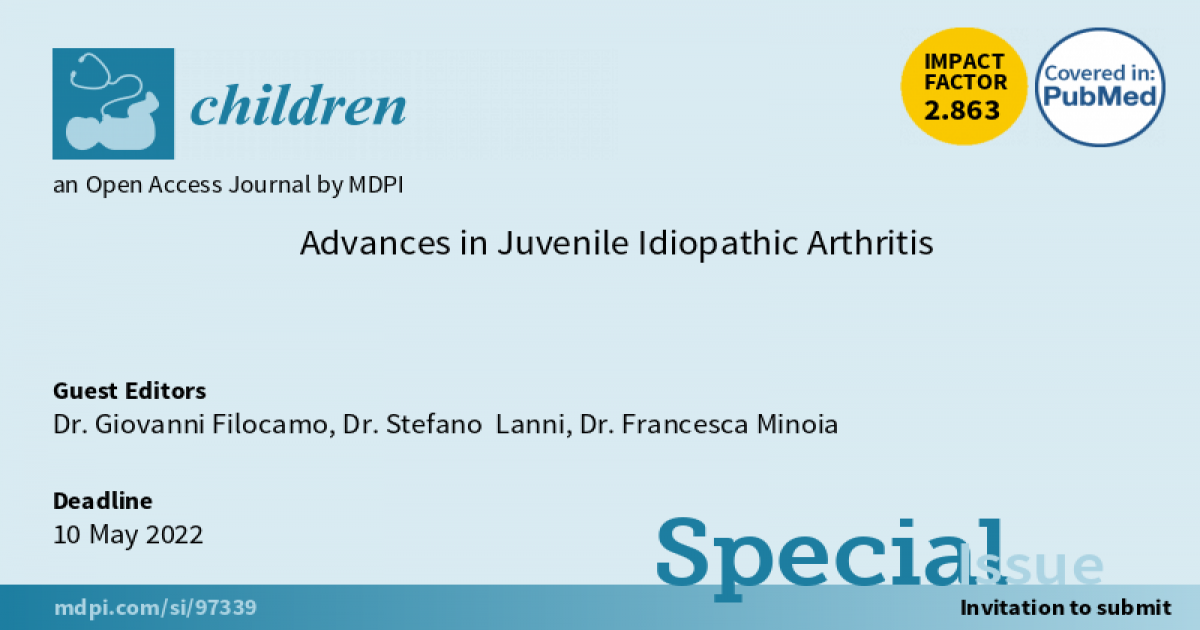Advances in Juvenile Idiopathic Arthritis
A special issue of Children (ISSN 2227-9067). This special issue belongs to the section "Pediatric Allergy and Immunology".
Deadline for manuscript submissions: closed (10 May 2022) | Viewed by 18254

Special Issue Editors
Interests: outcome measures in rheumatology; JIA; intraarticular joint injections; biosimilars
Interests: ultrasound in the evaluation of patients with JIA; intraarticular joint injections
Special Issue Information
Dear Colleagues,
Juvenile idiopathic arthritis (JIA) is the most common chronic joint disease in pediatric rheumatology and encompasses a heterogeneous group of disorders. JIA is one of the major potential causes of permanent joint inability in childhood, and extra-articular complications such as chronic uveitis could significantly impact its morbidity. Systemic JIA is increasingly recognized as a specific entity with a peculiar crosstalk between the innate and adaptative immune system, and its life-threatening complication, the macrophage activation syndrome, requires prompt recognition and appropriate treatment.
The continuous improvements in translational research, the widespread use of intra-articular glucocorticoids, and the increasing availability of a broad spectrum of innovative therapies that are tailor-made to all different subsets of JIA have resulted in a dramatic change in the way to approach the disease and to a significant improvement of long-term outcomes.
The regular assessment of the disease through standardized outcome measures in association with feasible parent- and child-centered assessment tools became routinely adopted in the management of JIA and allowed increasing the quality of care of patients. Furthermore, coupling clinical examination with novel and sensitive imaging modalities in the evaluation of patients with JIA might foster the capacity to achieve earlier assessment of disease activity and to evaluate treatment efficacy more precisely. The goal of this Special Issue is to explore all these aspects by pointing out the state-of-the-art knowledge based on daily clinical experience and on evidence from literary reviews.
Dr. Giovanni Filocamo
Dr. Stefano Lanni
Dr. Francesca Minoia
Guest Editors
Manuscript Submission Information
Manuscripts should be submitted online at www.mdpi.com by registering and logging in to this website. Once you are registered, click here to go to the submission form. Manuscripts can be submitted until the deadline. All submissions that pass pre-check are peer-reviewed. Accepted papers will be published continuously in the journal (as soon as accepted) and will be listed together on the special issue website. Research articles, review articles as well as short communications are invited. For planned papers, a title and short abstract (about 100 words) can be sent to the Editorial Office for announcement on this website.
Submitted manuscripts should not have been published previously, nor be under consideration for publication elsewhere (except conference proceedings papers). All manuscripts are thoroughly refereed through a single-blind peer-review process. A guide for authors and other relevant information for submission of manuscripts is available on the Instructions for Authors page. Children is an international peer-reviewed open access monthly journal published by MDPI.
Please visit the Instructions for Authors page before submitting a manuscript. The Article Processing Charge (APC) for publication in this open access journal is 2400 CHF (Swiss Francs). Submitted papers should be well formatted and use good English. Authors may use MDPI's English editing service prior to publication or during author revisions.
Keywords
- juvenile idiopathic arthritis
- outcome measures
- ultrasound
- treatment
- biologics
- intra-articular glucocorticoids
- macrophage activation syndrome
Benefits of Publishing in a Special Issue
- Ease of navigation: Grouping papers by topic helps scholars navigate broad scope journals more efficiently.
- Greater discoverability: Special Issues support the reach and impact of scientific research. Articles in Special Issues are more discoverable and cited more frequently.
- Expansion of research network: Special Issues facilitate connections among authors, fostering scientific collaborations.
- External promotion: Articles in Special Issues are often promoted through the journal's social media, increasing their visibility.
- e-Book format: Special Issues with more than 10 articles can be published as dedicated e-books, ensuring wide and rapid dissemination.
Further information on MDPI's Special Issue polices can be found here.






